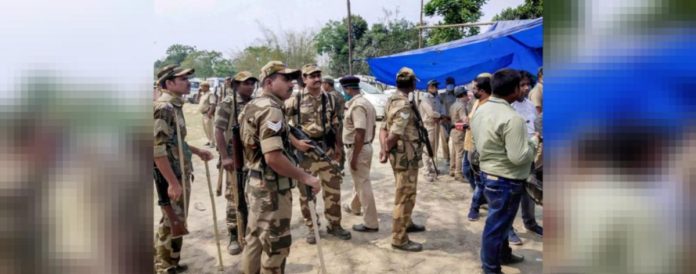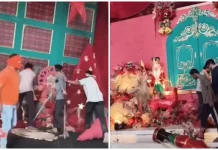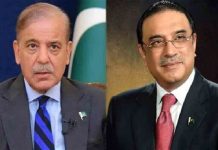DM Monitoring
Cooch Behar: During the fourth phase of the Assembly Poll, five people were killed in Sitalkuchi, Cooch Behar in poll-related violence, including four in firing by central forces triggering a political storm which further consolidated polarised voters. Elections in Cooch Behar have often been marred by violence.
In the run-up to the Panchayat Poll this time around, at least three political activists from the districts have been killed – many more injured in poll-related violence. Polling is underway in nearly 928 seats across 22 zilla parishads, 9,730 panchayat samitis, and 63,229 gram panchayats seats. Since the day the polls were announced on June 8, widespread violence has been reported from across Bengal. Fifteen people including a teenager have died, according to news agency PTI.
“In the last Assembly election, five people died. This time, we have been experiencing the sound of bomb blasts for over a month now. If we go to vote, they come to kill us, and if we don’t vote, we face consequences,” said Ajit Roy, a resident of Sitalkuchi.
“When it comes to voting, fear arises. You never know when gunshots will be fired. I have grown up in Sitalkuchi for 40 years. Since 2018, the unrest has not subsided. Only when everything is peaceful, will I go to vote. What is the value of life?” stated another local Shyamali Barman.
Last week, West Bengal governor C.V. Ananda Bose visited the conflict-affected areas of Dinhata in Cooch Behar district, where he met with the family members of two Bharatiya Janata Party (BJP) workers who lost their lives during the poll-related violence. However, despite the governor’s visit three BJP workers were shot even after the campaign ended for the Panchayat poll.
The entire village is currently in a state of shock following a brutal attack on Mafuzar Rahman, the husband of the Panchayat pradhan and a prominent figure of the Trinamool Congress. Rahman remains in critical condition as a result of the violent mob assault. This incident has had a significant impact on the region, which is traditionally dominated by the Trinamool Congress.
Uttarbanga Development Minister Udayan Guha dismissed any notion of anti-incumbency sentiment, “This is false news. Even during the Left-Congress alliance, there were similar clashes and killings in Dinhata during the Panchayat elections. Then, the CPI(M) Forward Block was involved, and now it’s Trinamool versus BJP.”
Dinhata, which borders Bangladesh, has been a focal point for political clashes in the region. As the political climate intensified, villagers near the Indo-Bangladesh border are visibly tensed. The fear in the Gitaldaha area has become so profound that when any outsider is seen entering the locality, the residents become frightened and retreat.
Udayan Guha is optimistic though. “Indira and Rajiv Gandhi were assassinated. BJP has adopted the same style. The killers are coming from Bangladesh and Assam, and BJP leaders are sheltering them in their homes. It’s a grand conspiracy. But they can’t stop us, we will win.”
In the neighbouring Panishala, a minority-dominated area, the BJP has fielded Muslim candidates. Its campaign is focussing on religious harmony. BJP is hoping to win the Zila Parishad in this district, and actively wooing its 25.54% Muslim population.
On the bus to Cooch Behar, I spoke to a few daily passengers, including businessmen and private sector employees. While the fight is primarily between the BJP and the Trinamool Congress, the Left might also perform better with the help of disgruntled Trinamool supporters. For the ruling party, inner fighting remains a major concern.
In Mekhligunj, local businessman Gaurav Roy made his preference clear. “I will definitely vote this time, even if it means risking my life. We will vote against those who have not allowed us to cast our votes in our area for the past few years! We will see who the strong candidate against them (Trinamool) is – we want someone honest and respectable who does good work but opposes them. Maybe we will vote for three different parties in three tiers of voting.”
Throughout the district, there is a quiet but simmering discontent against the ruling party. With the Rajbanshi community accounting for 65% of the vote in Cooch Behar, Ananta Maharaj, a prominent leader of the Rajbanshi community and the head of one faction of the Greater Cooch Behar Peoples’ Association, is gaining prominence among leaders from both the Trinamool Congress and the BJP.
Speculations are circulating that the BJP plans to nominate Ananta Maharaj for the Rajya Sabha to secure the backing of the Rajbanshi community. However, Maharaj prefers to keep himself detached from political debates and solely maintains direct communication with the top leaders of both parties. He has recently unveiled a grand mansion in Cooch Behar, advocating for Rajbanshi leadership and the formation of a separate state.
The demand for a separate state for Cooch Behar was initially voiced in 2001 with the slogan “Kamta in North, Mamata in South.” Despite 22 years passing, the sentiment remains strong within the Rajbanshi community. Greater Cooch Behar seeks statehood alongside North Bengal.
Ahead of the Panchayat polls, a recent video clip featuring Kamtapur Liberation Organisation (KLO) leader Jeevan Singh surfaced on social media. In the video, Singh accuses Mamata of conspiring against Union Minister Nishit Pramana and calls upon Rajbanshis to support the BJP in the elections.
CPI(M)’s Tarini Roy was a Rajya Sabha MP from Cooch Behar for a long time. He said, “This is all just a charade by the RSS. We have recognised their true face. The BJP MP who is issuing such threats today was once a youth leader of the Trinamool Congress and later switched. Everyone should know who wants to divide the people based on caste, religion, and language. The Left has secured the rights of the impoverished, giving Rajbanshis and tribals ownership of 66.17% of the land in this district.”
Union minister Nishith Pramanik is vigorously campaigning within the district and has not extended his poll campaign beyond the district. “This is mere propaganda. I am not confined to my own area. After my victory, I travelled across North Bengal in a 10-day march instead of three-day mandated by the party. I have nothing to say or do about Trinamool anymore. They are sinking into their own mess. We stand with the most oppressed Rajbanshis.”
Interestingly, in Cooch Behar, the only party which had prominent political leaders from the Rajbanshi community leader is CPI(M). From District Secretary of the party Anant Roy to ex-MP Tarini Roy, there are quite a few senior Rajbanshis leaders.
The Left parties claim that the fight was between the king and the people, and it seems that the spirit of that fight is returning. Prashanta Roy, a teacher from the Rajbanshi community, said, “We have assimilated into the mainstream of society. But now, in order to secure the votes, we are resorting to caste and identity politics. We should not accept it.”
As the district prepares for the Panchayat polls, the political environment in Cooch Behar resembles more of a rehearsal for the Lok Sabha elections.




